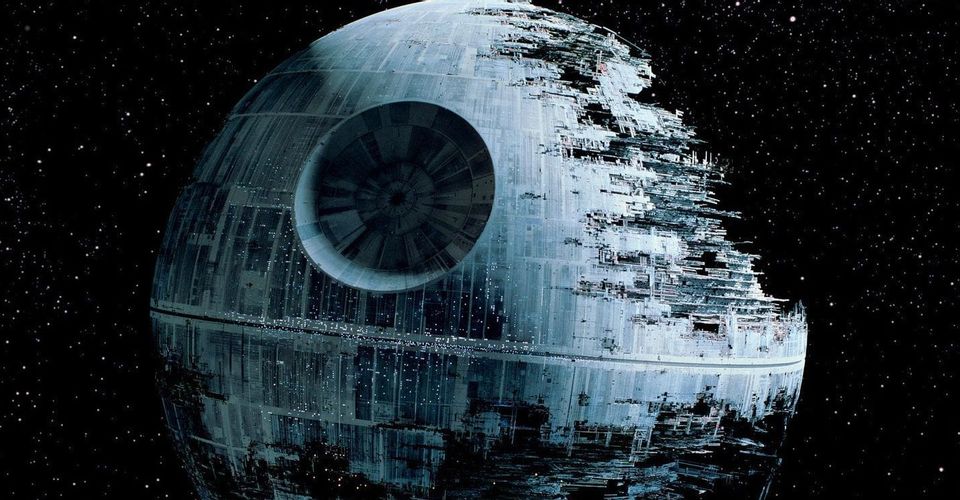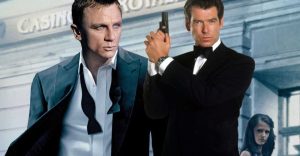Star Wars Set Decorator Reveals Design Inspirations of The Empire

Death Stars, Star Destroyers, and monuments to the Galactic Empire. Every movie fan knows the villains of Star Wars for their iconic designs, architecture, and militaristic bravado. Evil? Absolutely. But it wouldn’t be as memorable if it wasn’t also… beautiful. And thanks to new-behind-the-scenes details from one of the people who shaped that design, fans can appreciate George Lucas’s Star Wars universe in a whole new way.
The new insights come directly from Lair: Radical Homes and Hideouts of Movie Villains by Chad Oppenheim and Andrea Gollin, a new book taking a closer look at some of cinema’s most iconic ‘evil headquarters’ (from a more architectural/engineering perspective). Asking the question, “why do bad guys live in good houses?” the book includes interviews with a variety of Hollywood production designers, artists, and others. Amidst the glimpses into classic designs, Lair also includes a talk with Star Wars Set Decorator Roger Christian, offering new details on the making of the George Lucas long-shot made on an impossible budget. But which led to some truly iconic shortcuts and design ingenuity as a result.
The book itself will be available on November 5th, but we’re able to give fans of cinematic architecture and set design a small preview, including the interview with Roger Christian– the self-described “third person hired on Star Wars”–describing how the look of the movie took shape. Beginning with the cold, calculated, machine-like designs of the intimidating Empire.

Despite their fascist, brutal power structure, the origins of the Star Wars villains in Nazi Germany are often undiscussed (for obvious reasons). The politics of the Third Reich are of Earth, and not the galaxy far, far away, but the architecture and the mentality behind it was a direct influence for production designer John Barry. Christian explains:
When it came to the Death Star, that was inspired by the Reich architecture of Albert Speer, obviously. When you look at Nazi architecture, it’s very black with red on it. Very simple and very daunting — and strangely beautiful. And that’s exactly the Death Star.
There’s no denying Christian’s praise for the ominous, towering, and precision atiitude conveyed by the Empire’s design. It’s because of that impressive design that most viewers will never notice the walls made of cheaply-printed plastic sheets attached to plywood–just one of the many ways the set designers and decorators were forced to get creative with their shoestring budget in bring not one, but TWO cosmic worlds to life.

Christian explains how Lucas established the divide between Luke’s warm, organic world on Tatooine, and that of the unnatural, cold Empire in space (a dichotomy between Western and Sci-fi perfectly encapsulated by the two movies Lucas showed to the crew to prove his point: Once Upon a Time in the West, and 2001: A Space Odyssey). But for Barry, it was another chance to use the fiction of the film’s moon-sized battle station to make the sets achievable:
With George, [2001: A Space Odyssey] was too sci-fi like for what we had in mind for Star Wars. In addition, John Barry… had architectural training, so in the script, where it said the Death Star had huge, long corridors, his advice was, “Let’s make them curved because it’s a Death Star, it’s planet sized.” That made them more interesting, I thought. He also designed the round table where Vader and the officers of the Empire sit, and that was meant to be reminiscent of King Arthur’s Round Table… What was clear to us was that we didn’t want a sort of James Bond villain interior. We wanted something much darker. The Death Star was his place of worship, if you like, so it had to be iconic.
The thing with science fiction is you don’t have anything to reference. When you’re doing a period film you can say, “Oh, it’s the 1840s,” and you know the right clothes and furniture. With Star Wars, there was nothing. Only George’s descriptions in the script as this kind of evil world. Quite simple. But Ralph McQuarrie’s original paintings included a Death Star corridor and a beautiful sketch of Darth Vader with a lightsaber, fighting. Those gave us the key to it.

Those interested in the full interview with Christian, as well as detailed architectural looks at the Death Star and other iconic villain hangouts, can pre-order Lair: Radical Homes and Hideouts of Movie Villains now, or look for it at your local comic shop and bookstore on November 5th, 2019.
From Atlantis in The Spy Who Loved Me to Nathan Bateman’s ultra-modern abode in Ex Machina, big-screen villains often live in architectural splendor. From a design standpoint, the villain’s lair, as popularized in many of our favorite movies, is a stunning, sophisticated, envy-inducing expression of the warped drives and desires of its occupant. Lair: Radical Homes and Hideouts of Movie Villains, celebrates and considers several iconic villains’ lairs from recent film history.
About The Author


















